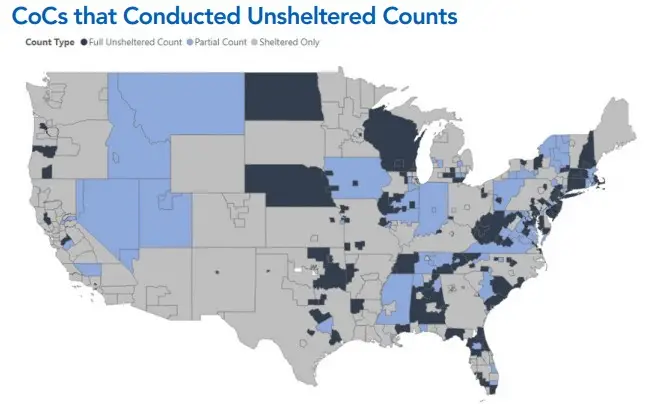
Because of issues related to the coronavirus pandemic, the Department of Housing and Urban Development’s annual homeless report is missing a count of unsheltered homeless for almost half of local jurisdictions.
HUD released its annual Homeless Assessment Report to Congress on homelessness in America last month. This year’s report is mostly focused on homeless people living in shelters. Many of those that had counts of unsheltered people gathered only limited information.
The data was collected by Continuum of Care networks that coordinate homeless services in a local area. HUD had encouraged local CoCs to determine whether doing counts of unsheltered homeless people in January 2021 would pose a high risk of spreading COVID-19. At that time, there was a lack of widespread access to vaccines.
Many jurisdictions opted not to do the unsheltered count because their staff capacity was already stretched thin due to other pandemic response efforts. Many also were concerned about spreading COVID-19 among people experiencing homelessness, assistance providers, and volunteers.
Only 54% of local jurisdictions that normally do counts of unsheltered people did so in January, 2021. Those areas represented 22% of unsheltered people that were counted in 2020.
More than half of the places that had counts did only a limited headcount. This means that specifics like race, age, number of children, or veteran status are not available for many of the homeless in this country.
Few places on the west coast had a count of people without shelter. This task is especially difficult in west coast states, because they’ve had the most people living outdoors over several years. In last year’s report, California alone accounted for more than half (51%) of the nation’s unsheltered population. Both California and Oregon were also among the top three states with the highest rate of homeless persons who were unsheltered.
HUD was still able to report on homeless people living in shelters or transitional housing for 2021. The annual report always includes an inventory of shelter beds. All local jurisdictions were able to update their information for the shelter inventory.
Key findings about shelters and transitional housing include:
- On a single night in January 2021, more than 326,000 people were living in shelters.
The good news is that the number of people living in shelters declined by 8% since 2020. About 60% were individuals and 40% were in families with children. - The number of veterans in shelters decreased by 10% in 2021.
This is the largest drop since 2015-2016. Unaccompanied youth in shelters also declined by 8%. - The number of families with children living in shelters fell even more.
While individuals in shelters declined by 2% in 2021, families with children in shelters dropped by 15%. - The total number of emergency shelter and transitional housing beds remained about the same in 2021 as the year before.
However, occupancy rates fell because of pandemic-related issues. - Shelter occupancy rates dropped from 82% in 2020, to 73% in 2021.
Many shelters reduced capacity to promote social distancing. Many people experiencing homelessness were also worried about staying in crowded places with shared bathrooms during a pandemic. - There was a decline in shelter beds, but a 134% increase in non-congregate shelter units.
This shows that many places started using hotel and motel vouchers during the pandemic. These units allow homeless persons and families to shelter safely or quarantine as needed.
